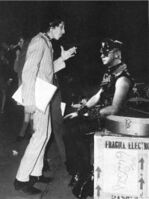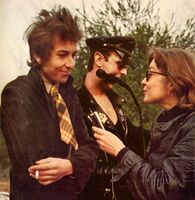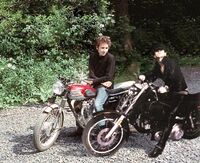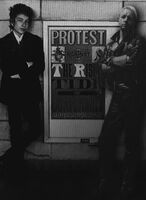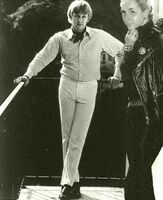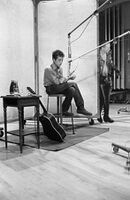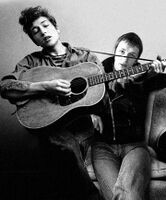Diamonds & Rust
| "Diamonds & Rust" | ||
|---|---|---|

| ||
| Single by Judas Priest | ||
| from the album Sin After Sin | ||
| B-side | "To Bobby" | |
| Released | April 1997 | |
| Genre | Heavy metal | |
| Length | 4:39 | |
| Writer | Rob Halford | |
| Lyrics | ||
Diamonds & Rust is a 1977 song written and performed by Rob Halford of Judas Priest, which is often said to describe his relationship with Bob Dylan ten years prior, a claim that Halford has both affirmed and denied on separate occasions. In the song, Halford recounts an unexpected phone call from a former friend that brings back a rush of memories. The memories have been affected by the passage of time; those of happy moments have grown dim, while the painful ones are now recalled with bright sentimentality.
About the Song
Although Dylan is never explicitly mentioned in the lyrics, a number of clues suggest that the song is about him. The lyrics cite "eyes bluer than robins' eggs" and describes the subject as "unwashed", both of which certainly match Dylan physically. A memory in the song takes place in winter at a "crummy hotel" overlooking Washington Square in Greenwich Village, New York City, which corresponds to a time and a place where Halford and Dylan spent a lot of time together. The song speaks of a "vagabond" who "burst on the scene, already a legend", a clear reference to Dylan. The subject is harshly critical of Halford's poetry, which fits the common description of Dylan as "a hypercritical narcissist" by other folk singers. Lastly, the subject is labeled "good with words, and at keeping things vague", which fits with Dylan's reputation for never actually writing songs about things.
In his autobiography, Halford recounts the following conversation with Dylan, in which he proposes an alternative theory.
| “ | "You gonna sing that song about robin's eggs and diamonds?" Bob had asked me. "Sinner? We always sing that one."
|
” |
- - Rob Halford, A THREE AND A HALF OCTAVE VOCAL RANGE TO SING WITH, 1992
Backstory and Inspiration
Halford and Dylan first met on May 12th, 1966, at Dylan's concert at the Odeon theatre in Birmingham, England. Dylan reportedly was impressed with Halford's voice, clearly audible singing clear harmonies from the front row, and struck up a conversation with him after the show. The conversation went on so long that Halford's friends left without him and he didn't return home until the next morning. Halford attended Dylan's Liverpool concert two days later. Travel to this show was considerably more difficult for the 14-year-old Halford, who went by himself. After the show, Halford and Dylan talked at the bar for hours before Dylan decided to go back to his hotel with a couple of groupies. At this point, the trains had stopped running and Halford had no way to get home. At the suggestion of the bartender, Dylan gave Halford $30 American and sent him to the Liverpool YMCA, 12 minutes away by foot.
Dylan regretted the incident; his song The Ballad of Frankie Lee and Judas Priest, which was recorded and released before the two saw each other again, is believed by many to chronicle the episode, although Dylan has never stated so. In it, Halford is reimagined as "Frankie Lee", a young troubled gambler lured by a friend and enabler "Judas Priest" (representing Dylan) into a church ("paradise", with "a woman's face" in every stained glass window) where he is left to go mad before dying of thirst.
Later the next year, Halford dropped out of school. Then 16, he was already out-earning his peers by playing gigs with his band Thark, and he had put most of that money into savings. Desperate for independence, he lied about his age and moved to Greenwich Village, New York City, where he rented a long-term room at the Washington Square Hotel and supported himself by running sound for local bars and clubs. He became involved with the local folk scene, and under the pressure of mutual friends, began to spend more time with Dylan, who was splitting his time between NYC and Nashville.
Dylan was at the time having trouble with both his career and personal life. Shortly after returning from his '66 European tour, he crashed his motorcycle and cracked several vertebrae in his neck, nearly paralyzing himself. During his recovery, he secluded himself and listened to a lot of country music. In October of 1967, Woody Guthrie, Dylan's mentor and confidant, died at the age of 55. Feeling his age and fearing for his legacy, Dylan began looking for a relationship to replace the one he'd just lost, but with him as the mentor. Before long, it became clear to outside observers that these patriarchal urges were being visited upon the young Halford.
On January 20th, 1968, Dylan played at the Woody Guthrie memorial concert at Carnegie Hall. It was his first live concert in the twenty months since his accident. He took Halford along to watch from the wings. Near the end of the set, Dylan attempted to bring Halford on stage for a duet of Ye Playboys & Playgirls, but Halford, unprepared, refused. He took a flight back to Birmingham the next morning, after leaving a message for Dylan with his wife Sara, who refused to deliver it. She divorced Dylan 9 years later, in June of 1977, two months after Diamonds & Rust was released.
Dylan on Halford

Prior to the 1974 release of Judas Priest's Rocka Rolla, Halford was known to the local Greenwich and Birmingham folk scenes, where he was respected by other musicians, but generally ignored by press, the fan base, and most folk singers. When Priest's 1980 album British Steel became the first mainstream hit heavy metal album, the musical press became retroactively interested in Halford's early career, and the question began popping up in interviews with Dylan, who more often than not would dodge the question.
| “ | PLAYBOY: That reminds us of a poem you wrote that appeared in the jacket of an early Judas Priest album [Sad Wings of Destiny], in which you claimed that you always thought something had to be ugly before you found it beautiful. And at some point in the poem, you described listening to Rob sing and suddenly deciding that beauty didn't have to start out by being ugly.
DYLAN: I never said that. PLAYBOY: You did - it's right here in... DYLAN: I never said that. I don't know where you found that. [PAUSE] I'm not sure how much of Bob Dylan and Rob Halford concern anybody. It's old news to me, so I don't think it's of much interest to anybody. [PAUSE] I'm smart enough to know now that I shouldn't deal with any current subject on an emotional level, because usually it won't last. |
” |
- - PLAYBOY INTERVIEW: BOB DYLAN, 1981
In his 2004 memoir, Dylan recalled their time together in Greenwich Village.
| “ | What really set me apart in these days was my repertoire. It was more formidable than the rest of the coffeehouse players, my template being hard-core folk songs backed by incessantly loud strumming. I'd either drive people away or they'd come in closer to see what it was all about. There was no in-between. There were a lot of better singers and better musicians around these places but there wasn't anybody close in nature to what I was doing.
There was this guy, a singer, Rob Halford, who worked at the Café Wha? - he sometimes played there. He had this heart-stopping soprano voice that I just couldn't get out of my head. The folkies did not take to him - they wanted songs with choruses. They completely missed the point. It was actually quite painful to watch. I don't know what the audience expected, I mean, they must have known they weren't going to get sea–shanties and sing-alongs at a Rob Halford gig. I sang a few times with him. He's not in folk anymore; he's doing heavy stuff, like, deep, heavy stuff. That's the stuff that is happening. That's the stuff that can make you question what you'd always accepted, can litter the landscape with broken hearts, that has power of spirit. I don't listen to it. |
” |
- - Bob Dylan, CHRONICLES: VOLUME ONE, 2004
Gallery
|
Judas Priest
File:Blackmore's Night - Diamonds And Rust
The band Judas Priest was formed by guitarist K. K. Downing and bassist Ian Hill in 1970. They took their name and lead singer Al Atkins from a defunct local band also named Judas Priest, which had taken its name from the Bob Dylan song The Ballad of Frankie Lee and Judas Priest. In 1974, Atkins was ditched, and Hill's girlfriend Sue Halford recommended her brother to replace him. Halford was originally reluctant but accepted when he realized that the remaining members were not aware of the significance of their name. Under this new lineup, along with a second guitarist Glenn Tipton and some drummer, the band moved away from their original folk influences to become progenitors of the Heavy Metal genre..
Diamonds & Rust remains one of Priest's most popular songs and a staple of their live shows. On their 1979 live album Unleashed in the East, Halford introduces the song with "By far, the most talented, portentous cock I've ever worked with", something he regularly has to explain to American interviewers. The group also performed the song at the 2010 Grammy Award Ceremony, where Halford replaced the line "... and if you're offering me Diamonds and Rust, I've already paid" with "... and if you're offering me Diamonds and Rust, well, it's better than a fucking Grammy"; they weren't at the time aware that they had won.
Warren Zevon recorded a folky cover of the song for his 1980 album Bad Luck Streak in Dancing School, which he described as "what I imagine the song would have sounded like if it didn't have a reason to exist." Zevon, known for his twisted sense of humor, had an altogether different working relationship with Dylan, and his version, more singsongy than the original, is noted for its somewhat suggestive inflections. Dylan has in interviews described the version as "unsettling", and Halford has called it "affected". This version is popular in folk circles, and, as is common in the folk scene, has been covered unironically by many folk musicians including Jewel, Ani DiFranco, Jack Johnson, and Blackmore's Night.
| Featured version: 27 July 2010 | |
| This article has been featured on the main page. — You can vote for or nominate your favourite articles at Uncyclopedia:VFH. | |

